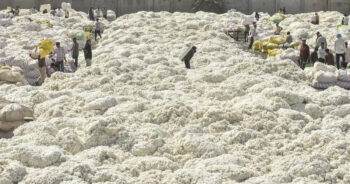 India’s cotton and yarn markets face challenges due to global economic concerns, which may limit demand from downstream industries and affect exports. While cotton prices rose by half to one per cent in spot and future markets on Tuesday due to ICE cotton trading higher, cotton yarn remained stable due to weak demand in South India. In North India, cotton yarn is under pressure due to the absence of buyers.
India’s cotton and yarn markets face challenges due to global economic concerns, which may limit demand from downstream industries and affect exports. While cotton prices rose by half to one per cent in spot and future markets on Tuesday due to ICE cotton trading higher, cotton yarn remained stable due to weak demand in South India. In North India, cotton yarn is under pressure due to the absence of buyers.
Experts predict that cotton yarn markets may see some support in April, but there is unlikely to be a significant increase in prices as natural fibre prices are already high.
Indian markets received around 180 lakh bales of 170 kg cotton so far, which is 50 lakh bales lower than the same period last season, which saw 230 lakh bales. In February 2023, the Cotton Association of India (CAI) revised downward the cotton production estimate to 313 lakh bales, slightly up from last season’s final estimate of 307 lakh bales but lower than the previous month’s estimate of 321.50 lakh bales.
As a result, around 40 per cent of the crop is left with farmers. Despite lower arrivals, cotton prices did not rise due to the disparity between Indian and international prices. This disparity discouraged exports from India, which only managed to export 8 lakh bales of cotton so far. CAI had expected 30 lakh bales of cotton to be exported during the current season, compared to 43 lakh bales in the previous season. However, the expectation may not be met due to continued price disparity.
It should be noted that the cotton industry has suffered a consumption loss in the current season due to a reduction in production by spinners. This was largely due to lukewarm demand from downstream industries and price disparities, which discouraged spinners from increasing their production. In response to the costlier cotton, many large-sized spinners in North India have switched to polyester-cotton and poly spun yarn. The CAI has confirmed a lower consumption projection from 318 lakh bales to 300 lakh bales, and industry experts predict that consumption may further decrease due to lower production.
The lower production was somewhat offset by poor demand for garments from both the export and domestic markets. Furthermore, the lower export of cotton was compensated for by the reduction in the production of the natural fibre.
A prominent trader from Gujarat Chetan Bhojani told, “Cotton prices are unlikely to increase significantly because of disparity at every level. Ginners and spinners are facing disparity so they are running production will limited capacity. Market uncertainty also reduced market pipeline. If buyers from downstream industry come back to market in April to build stock for off-peak arrival season, cotton prices may improve but upward movement may be very limited.”
Cotton yarn market sources are expecting better demand next month, but demand from end-consumer is still uncertain. They feel that cotton yarn market was running on domestic demand and export demand is still not encouraging. Recent upheaval in financial market of the US and Europe also shook the market sentiments. Exporters expect better orders from global brands from June onwards but high inflation, increasing interest rates and economic worries may disappoint them.










